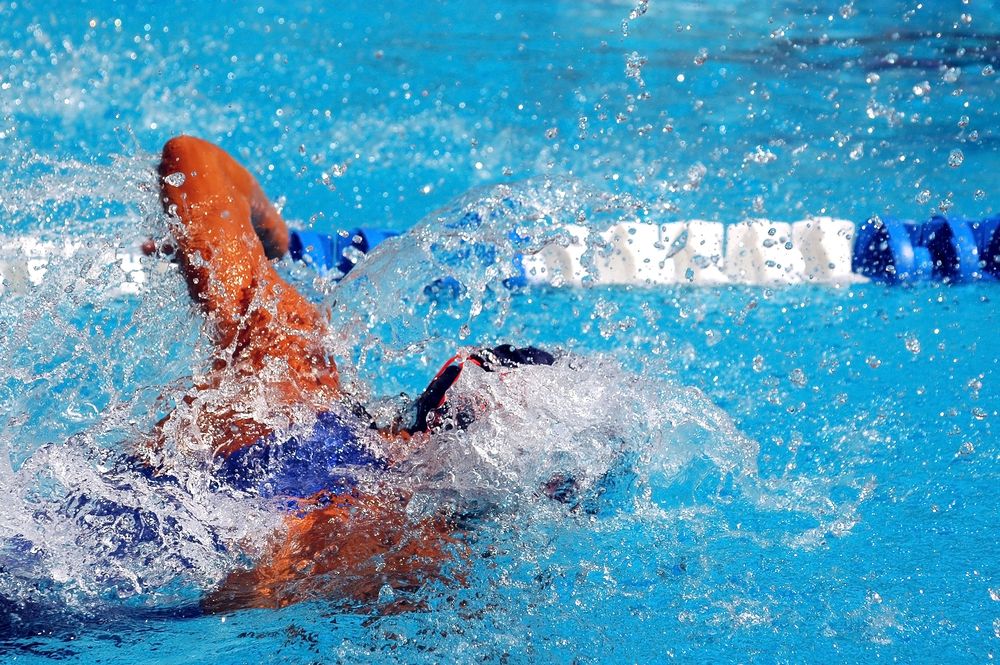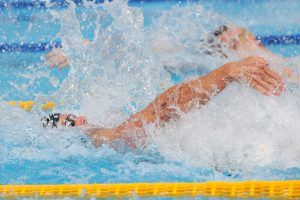There are a heap of college swimming recruiting myths floating out there. From having your entire education + spending money being paid for, to the number of scholarships out there, to the very act of how you should go about getting one.
Here are six of the most common myths about getting recruited for college swimming to help you get a better idea of what the recruiting process actually looks like–
1. The coaches will beat down your door.
The dream for every college-bound swimmer is that they are interrupted during an afternoon snack session from a hearty pounding on the front door from an elite, Division 1 head coach.
While you think your swimming is killer, that doesn’t mean the coaches have had time to pick their heads out of a mountain of administrative duties, recruiting other swimmers, and of course, coaching their teams. (Many college coaches also coach club teams and/or teach courses at the institution as well.)
SEE ALSO: 10 First-Time Questions to Ask a College Swim Coach
At the end of the day, it’s on you to market yourself in the best manner possible to colleges and universities in order to get that scholarship.
2. Your swimming performance will over-shadow any academic shortcomings.
This is the most dangerous of the college swimming recruiting myths. Unless you are the next Michael Phelps – at which point you’re better off going pro anyways – a high GPA is critical to getting into the school of your dreams, if only for the fact that a less than stellar GPA can make you ineligible for some scholarships.
If your grades are continually faltering you’ll soon find that interest from college programs will fade quickly. Think of it from their point-of-view – nobody wants to have to try and motivate or babysit a student that is not interested in maintaining academic eligibility.
College programs want a student that is going to rep for four years – not flunk out spectacularly after one semester.
(Another key point that will become even more clear towards the end of the article is that there is much more money available in terms of academic scholarship than for strictly athletics.)
3. You should only hit up the dream schools on your list.
Visiting with numerous programs is not only a good personal experience, but you will get a better idea of what you want in a college atmosphere. Whether it is an official or an unofficial visit, get out there and see what the various programs have to offer. It can be easy to dismiss a school on paper, but you will never really know how good of a fit it can be for you until you get there and see it for yourself.
4. You need to produce a 45 minute highlight film.
Relieve yourself of the need of showing the same race in different speeds, of showing slo-mo sequences, and of over-producing the video. If the video is posted up on YouTube or Vimeo, the coach can rewind, slo-mo and freeze-frame as much as they like. Avoid embracing your inner James Horner and ditch the soundtrack. Keep it short and succinct.
SEE ALSO: How to Get Recruited for College Swimming
5. You can wait until your senior year to start looking.
The recruitment process usually takes over a year, so it’s in your best interest to start looking around and showing intent before your senior year gets started. Putting together a list of prospective schools in your freshman and sophomore years is not uncommon, and having a sizable list allows for options in the event coaches and/or programs drastically change.
While there are some limitations on how much contact college coaches can have with recruits, it is best to get the process started no later than during the junior year.
6. Athletic scholarships will cover everything.
Big no-no here. Outside of the major funded sports (football and basketball in particular) there is a very finite amount of scholarship dollars available. Many coaches will try to stretch that money out across as many athletes as possible, meaning that there will be out-of-pocket costs at some point.
And even if you do get a full ride to the institution of your dreams, there will inevitably be costs and expenses that you’ll incur, not limited to extra travel, spending money, and leisure time expenses. (No, Jagermiester isn’t covered within a stereotypical Div 1 scholarship.)
According to these stats from CollegeSwimming.com, here is a breakdown of how many scholarships are out there—
- Just under 1,700 men’s and 3,100 women’s scholarships available. Only 1/3 of those are awarded each season.
- With the obvious in-balance it means the odds of getting a scholarship for boys are also proportionally lower – 1 of 48 senior boy swimmers will get a scholarship, while it’s only slightly better for the girls at 1 in 31.
- Approximately 1 out of 10 high school senior swimmers will go on to swim in college.
- 44% of collegiate swimmers compete at the D3 level and therefore receive no athletic scholarship whatsoever.
At the end of the day, you need to swim your butt off, get good grades, and be proactive!















